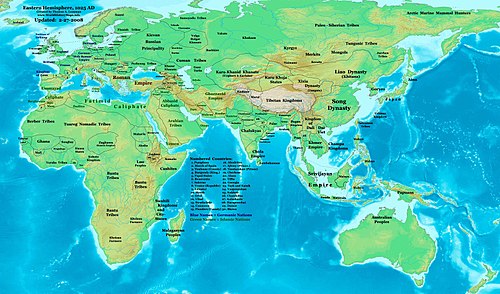List of countries by population in 1000
| Historical Demographics | ||
|---|---|---|
 Altar of Domitius Ahenobarbus | ||
| Articles | ||
| Demographic history | ||
| Historical demography | ||
World population estimates
| ||
| List of Countries by Population | ||
1 |
1000 | 1500 |
This is a list of countries by population in 1000. The bulk of these numbers are sourced from Alexander V. Avakov's Two Thousand Years of Economic Statistics, Volume 1, pages 12 to 14, which cover population figures from the year 1000 divided into modern borders. Avakov, in turn, cites a variety of sources, mostly Angus Maddison.
| Country/Territory | Population c. 1000 estimate | Percentage of World Population |
|---|---|---|
| World[1] | 390,000,000 [notes 1] | – |
| Song China[2] | 32,500,000–80,000,000 | 19.23% |
subdivisions
|
4,000,000– 20,000,000 | 1.03%-5.13% |
| Pala Empire | Less than 16,000,000–17,000,000[3] | 4.10%-4.36% |
subdivisions
|
11,300,000–12,700,000[6] | 3.26% |
| 12,500,000 | 3.2051% | |
subdivisions
|
12,000,000 | 3.08% |
| Western Chalukya Empire
subordinate dynasties
|
9,000,000–10,000,000 | 2.44% |
| Buyid Persia | 6,500,000–8,500,000 | 2.18% |
| Khitan Liao[12][13][14][15] | 5,250,000–7,750,000 | 1.99% |
| 7,200,000 | 1.8% | |
| 7,000,000 | 1.79% | |
| Al-Andalus | Less than 7,000,000 | 1.79% |
| Gurjara-Pratihara empire[4]
subdivisions
|
6,000,000–7,000,000 | 1.79% |
| 5,400,000 | 1.38% | |
| 3,000,000–5,000,000 | 0.77%-1.28% | |
subdivisions
|
4,500,000 | 1.15% |
subdivisions
|
4,000,000 | 1.0% |
| Wari Empire
subdivisions
|
3,000,000 | 0.77% |
subdivisions
|
2,087,000 | 0.54% |
subdivisions
|
2,000,000 | 0.51% |
| Pagan Kingdom[21] | 1,500,000-2,000,000 | 0.38%-0.51% |
| 1,250,000 | 0.32% | |
| Kingdom of England[23][24] | 1,250,000 | 0.32% |
| Early Lê dynasty (Đại Việt) [25] | 1,200,000 | 0.31% |
| 1,000,000 | 0.26% | |
subdivisions
|
1,000,000 | 0.26% |
| Zagwe Kingdom
subdivisions
|
1,000,000 | 0.26% |
| 900,000 | 0.23% | |
| 630,000 | 0.15% | |
Kingdom of Denmark[23]
|
620,000 | 0.13% |
| Kingdom of Croatia[8] | 412,000 | 0.11% |
Kingdom of Sweden[23]
|
400,000 | 0.10% |
| Kingdom of Scotland[23] | 300,000 | 0.08% |
| Duchy of Bosnia[8] | 286,000 | 0.07% |
Kingdom of Norway[23]
|
200,000 | 0.05% |
| 60,000 | 0.02% |

See also
- List of countries by population
- List of countries by population in 1500
- List of countries by population in 1600
- List of political entities in the 10th century
Bibliography
- Buringh, Eltjo (2010). Medieval Manuscript Production in the Latin West. ISBN 978-9004175198.
- Herlihy, David (1989), "Medieval Demography", in Strayer, Joseph R. (ed.), ISBN 0-684-17024-8.
- Kiernan, Ben (2019). Việt Nam: a history from earliest time to the present. ISBN 9780190053796.
- Bolt, Jutta, Robert Inklaar, Herman de Jong and Jan Luiten van Zanden (2018). "Maddison Project Database, version 2018".
{{cite web}}: CS1 maint: multiple names: authors list (link) - Urlanis, B T︠S︡ (1941). Rost naselenii︠a︡ v Evrope : opyt ischislenii︠a︡ [Population growth in Europe] (in Russian). Moskva: OGIZ-Gospolitizdat. OCLC 42379320.
Notes
References
- ^ Data from United Nations Department of Economic and Social Affairs, Population Division. Archived 2014-03-20 at the Wayback Machine
1950–2100 estimates (only medium variants shown): (a) World Population Prospects: The 2008 Revision. Archived 2010-08-19 at the Wayback Machine
Estimates prior to 1950: (b) "The World at Six Billion", 1999.
Estimates from 1950 to 2100: (c) "Population of the entire world, yearly, 1950 – 2100", 2013.
2014: (d) http://esa.un.org/unpd/wup/Highlights/WUP2014-Highlights.pdf "2014 World Urbanization Prospects", 2014.]
2015: (e) http://esa.un.org/unpd/wpp/Publications/Files/Key_Findings_WPP_2015.pdf "2015 World Urbanization Prospects", 2015.] - ^ Yue, Shi (1982). Tai ping huan yu ji (in Chinese). Gu jiu shu dian.
- ^ a b c d e f g h i j k l Maddison 2018.
- ^ a b "Populations of Largest Cities in PMNs from 2000BC to 1988AD". Archived from the original (TXT) on September 29, 2007. Retrieved 2018-06-29.
- ^ a b c d e f g Buringh 2010, p. 72.
- ^ The lower figure comes from adding up the constituents in Buringh's figures. The higher is the combined population of Germany (5m), Austria (0.7m), Czechia (0.9m), Belgium (0.4m), the Netherlands (0.3m), Switzerland (0.3m), Slovenia (0.158m), a quarter of France (1.62m), and two-thirds of Italy (3.4m) in Avakov, p. 9-11.
- ^ "Appendix B: Growth of World Population, GDP and GDP Per Capita before 1820" (PDF). Archived from the original (PDF) on 8 May 2010.
- ^ ISBN 9781628941012. Retrieved 13 Oct 2017.
- ^ W. Treadgold, A History of the Byzantine State and Society, 570
- ^ "History 303: Populations". Archived from the original on 2015-08-26. Retrieved 2015-07-23.
- ^ The themes of Nikopolis, Hellas, Peloponnesos, Thessaloniki, Strymon, Cephalonia, and Crete.
- ^ Ebrey (1996), 166.
- .
- ISBN 978-7206055102.
- ISBN 9787520113977.
- ^ (a) Jean-Noël Biraben, "The History of the Human Population From the First Beginnings to the Present" in "Demography: Analysis and Synthesis: A Treatise in Population" (Eds: Graziella Caselli, Jacques Vallin, Guillaume J. Wunsch) Vol 3, Chapter 66, pp 5–18, Academic Press, San Diego (2005). (b) Jean-Noël Biraben, "An Essay Concerning Mankind's Evolution", Population, Selected Papers, Vol. 4, pp. 1–13 (1980). (c) Jean-Noël Biraben, "Essai sur l'évolution du nombre des hommes", Population Vol. 34 (no. 1), pp. 13–25 (1979).
- ^ Б.Ц.Урланис. Рост населения в Европе (PDF) (in Russian). p. 89.
- ISBN 9781107098466.
- PMID 33962951.
- ^ Euratlas Periodis Web – Map of Europe in Year 1000
- ISBN 978-0-8248-8008-8.
- ^ Péter Rabb, Natural conditions in the Carpathian Basin of the middle ages, 2007, p. 58
- ^ OCLC 42379320.
- ^ "History of Wales".
- ^ Kiernan 2019, p. 168.
- ISBN 978-0-691-02910-8.
